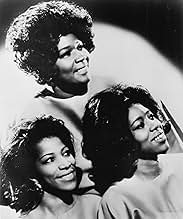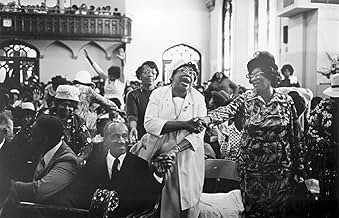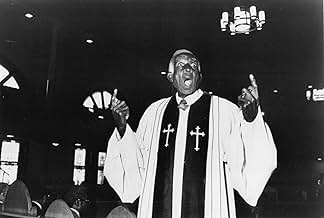Aggiungi una trama nella tua linguaDocumentary about the American gospel music scene, focusing on two of the movement's pioneering forces, Thomas A. Dorsey and Willie May Ford Smith.Documentary about the American gospel music scene, focusing on two of the movement's pioneering forces, Thomas A. Dorsey and Willie May Ford Smith.Documentary about the American gospel music scene, focusing on two of the movement's pioneering forces, Thomas A. Dorsey and Willie May Ford Smith.
- Premi
- 1 vittoria e 1 candidatura in totale
Willie Mae Ford Smith
- Self
- (as Willie May Ford Smith)
Billie Barrett GreenBey
- Self
- (as Billie Greenbey)
Rodessa Barrett Porter
- Self
- (as Rhodessa Porter)
Frank Campbell
- Self
- (as Rev. Frank W. Campbell)
Melvin Smotherson
- Self
- (as Rev. Melvin Smotherson)
Recensioni in evidenza
This film is a surprise and keeps the viewer interested! I rented this out of "professional" curiosity as wanting to check out documentaries. Also the fact that it is now 20 years old made me wonder how it would fly now. Well, time has not dented this film at all. The music is uplifting and the dynamics portrayed between not only family members but the some of the central people profiled (Willie Mae Ford Smith, Thomas A. Dorsey & Sallie Martin) are compelling, if not at times (in the light of human nature), somewhat humorous. As far as bringing gospel music into churches, Ms. Smith and Mr. Dorsey were definitely pioneers. Their struggle was unique, but they kept going and nurtured others who wanted to go this same route.
Never have I responded so thoroughly to people in a documentary. I initially became curious about it because of Roger Ebert who rated it so highly.
Now I have it in my collection and whenever I am feeling down, I watch it. In addition to Willie Mae Ford Smith and Thomas A. Dorsey, I love all of the other singers too. In an era when it is possible to feel numb about life, this film and its vivid people help you to process pain and sadness. What survivors! How I would like to meet all of these people. Some of these people are not conventionally pretty, but, oh my! they help you feel again. It is so moving to hear their reminiscences when many are shown later in their lives.
So sadly, many of them are no longer with us. We are all a little poorer without them. That's why we can be so thankful that this film was able to capture what we might have missed. What a terribly sad end to the life of Sallie Martin!
God bless mother Smith and Thomas Dorsey.
We are all richer for them.
Now I have it in my collection and whenever I am feeling down, I watch it. In addition to Willie Mae Ford Smith and Thomas A. Dorsey, I love all of the other singers too. In an era when it is possible to feel numb about life, this film and its vivid people help you to process pain and sadness. What survivors! How I would like to meet all of these people. Some of these people are not conventionally pretty, but, oh my! they help you feel again. It is so moving to hear their reminiscences when many are shown later in their lives.
So sadly, many of them are no longer with us. We are all a little poorer without them. That's why we can be so thankful that this film was able to capture what we might have missed. What a terribly sad end to the life of Sallie Martin!
God bless mother Smith and Thomas Dorsey.
We are all richer for them.
Documentaries really don't get much better than this. It's a look behind the scenes at a world few (particularly white) viewers get to see unless it appears on a religious TV show if you like in a town with a black population. We see the lives and performances of two gospel greats, Willie May Ford Smith and Thomas Dorsey. The documentary follows their lives from the early days and leads up to a big conference when the two dynamic subjects share an auditorium. The documentary shows the joy of gospel music in an age of cynicism. We feel the purity of expression here and see very little of the commercial trappings we see in so much of organized religion. People are singing because it feels good! People are responding to these singers because it feels good! People are saying amen because it feels good! Recommended as an antidote to the blahs.
March 30, 1983 "Say Amen, Somebody" Four stars
Movies / Roger Ebert "Say Amen, Somebody" is the most joyful movie I've seen in a very long time. It is also one of the best musicals and one of the most interesting documentaries. And it's also a terrific good time. The movie is about gospel music, and it's filled with gospel music. It's sung by some of the pioneers of modern gospel, who are now in their 70s and 80s, and it's sung by some of the rising younger stars, and it's sung by choirs of kids. It's sung in churches and around the dining room table; with orchestras and a capella; by an old man named Thomas A. Dorsey in front of thousands of people, and by Dorsey standing all by himself in his own backyard. The music in "Say Amen, Somebody" is as exciting and uplifting as any music I've ever heard on film. The people in this movie are something, too. The filmmaker, a young New Yorker named George T. Nierenberg, starts by introducing us to two pioneers of modern gospel: Mother Willie May Ford Smith, who is 79, and Professor Dorsey, who is 83. She was one of the first gospel soloists; he is known as the Father of Gospel Music. The film opens at tributes to the two of them - Mother Smith in a St. Louis church, Dorsey at a Houston convention - and then Nierenberg cuts back and forth between their memories, their families, their music and the music sung in tribute to them by younger performers. That keeps the movie from seeming too much like the wrong kind of documentary - the kind that feels like an educational film and is filled with boring lists of dates and places. "Say Amen, Somebody" never stops moving, and even the dates and places are open to controversy (there's a hilarious sequence in which Dorsey and Mother Smith disagree very pointedly over exactly which of them convened the first gospel convention). What's amazing in all of the musical sequences is the quality of the sound. A lot of documentaries use "available sound," picked up by microphones more appropriate for the television news. This movie's concerts are miked by up to eight microphones, and the Dolby system is used to produce full stereo sound that really rocks the theater. One of the phenomenons during screenings of this film is the tendency of the audience to get into the act. Willie May Ford Smith comes across in this movie as an extraordinary woman, spiritual, filled with love and power. Dorsey and his longtime business manager, Sallie Martin, come across at first as a little crusty, but then there's a remarkable scene where they sing along, softly, with one of Dorsey's old records. By the end of the film, when the ailing Dorsey insists on walking under his own steam to the front of the gospel convention in Houston, and leading the delegates in a hymn, we have come to see his strength and humanity. Just in case Smith and Dorsey seem too noble, the film uses a lot of mighty soul music as counterpoint, particularly in the scenes shot during a tribute to Mother Smith at a St. Louis Baptist church. We see Delois Barrett Campbell and the Barrett Sisters, a Chicago-based trio who have enormous musical energy; the O'Neal Twins, Edward and Edgar, whose "Jesus Dropped the Charges" is a show-stopper; Zella Jackson Price, a younger singer who turns to Mother Smith for advice; the Interfaith Choir, and lots of other singers. "Say Amen, Somebody" is the kind of movie that isn't made very often, because it takes an unusual combination of skills. The filmmaker has to be able to identify and find his subjects, win their confidence, follow them around, and then also find the technical skill to really capture what makes them special. Nierenberg's achievement here is a masterpiece of research, diligence and direction. But his work would be meaningless if the movie didn't convey the spirit of the people in it, and "Say Amen, Somebody" does that with great and mighty joy. This is a great experience.
Movies / Roger Ebert "Say Amen, Somebody" is the most joyful movie I've seen in a very long time. It is also one of the best musicals and one of the most interesting documentaries. And it's also a terrific good time. The movie is about gospel music, and it's filled with gospel music. It's sung by some of the pioneers of modern gospel, who are now in their 70s and 80s, and it's sung by some of the rising younger stars, and it's sung by choirs of kids. It's sung in churches and around the dining room table; with orchestras and a capella; by an old man named Thomas A. Dorsey in front of thousands of people, and by Dorsey standing all by himself in his own backyard. The music in "Say Amen, Somebody" is as exciting and uplifting as any music I've ever heard on film. The people in this movie are something, too. The filmmaker, a young New Yorker named George T. Nierenberg, starts by introducing us to two pioneers of modern gospel: Mother Willie May Ford Smith, who is 79, and Professor Dorsey, who is 83. She was one of the first gospel soloists; he is known as the Father of Gospel Music. The film opens at tributes to the two of them - Mother Smith in a St. Louis church, Dorsey at a Houston convention - and then Nierenberg cuts back and forth between their memories, their families, their music and the music sung in tribute to them by younger performers. That keeps the movie from seeming too much like the wrong kind of documentary - the kind that feels like an educational film and is filled with boring lists of dates and places. "Say Amen, Somebody" never stops moving, and even the dates and places are open to controversy (there's a hilarious sequence in which Dorsey and Mother Smith disagree very pointedly over exactly which of them convened the first gospel convention). What's amazing in all of the musical sequences is the quality of the sound. A lot of documentaries use "available sound," picked up by microphones more appropriate for the television news. This movie's concerts are miked by up to eight microphones, and the Dolby system is used to produce full stereo sound that really rocks the theater. One of the phenomenons during screenings of this film is the tendency of the audience to get into the act. Willie May Ford Smith comes across in this movie as an extraordinary woman, spiritual, filled with love and power. Dorsey and his longtime business manager, Sallie Martin, come across at first as a little crusty, but then there's a remarkable scene where they sing along, softly, with one of Dorsey's old records. By the end of the film, when the ailing Dorsey insists on walking under his own steam to the front of the gospel convention in Houston, and leading the delegates in a hymn, we have come to see his strength and humanity. Just in case Smith and Dorsey seem too noble, the film uses a lot of mighty soul music as counterpoint, particularly in the scenes shot during a tribute to Mother Smith at a St. Louis Baptist church. We see Delois Barrett Campbell and the Barrett Sisters, a Chicago-based trio who have enormous musical energy; the O'Neal Twins, Edward and Edgar, whose "Jesus Dropped the Charges" is a show-stopper; Zella Jackson Price, a younger singer who turns to Mother Smith for advice; the Interfaith Choir, and lots of other singers. "Say Amen, Somebody" is the kind of movie that isn't made very often, because it takes an unusual combination of skills. The filmmaker has to be able to identify and find his subjects, win their confidence, follow them around, and then also find the technical skill to really capture what makes them special. Nierenberg's achievement here is a masterpiece of research, diligence and direction. But his work would be meaningless if the movie didn't convey the spirit of the people in it, and "Say Amen, Somebody" does that with great and mighty joy. This is a great experience.
Just wanted to say this movie/documentary was on last Sunday, April 20, 2008 and I had not seen it in years. Oh! what a joy it was to see it again. Mother Willie Mae Ford Smith is absolutely wonderful and her performances speaks for it self. What a lady she was & what a voice. The movie @ times is very funny especially the scenes with old "crusty" Sallie Martin & Mother Smith discussing when the 1st convention was and the look Mother Smith gives is to funny. The scenes in St. Louis, Mo are so familiar to me since I was born and raised in St. Louis. The scenes at the old Union Station (I remember when it was run down and dilapidated like that) and I later worked there after they remodeled it @ the Omni/Hyatt Hotel, and I also visited the church where they had the tribute to Mother Smith. My favorite parts are Delois Barret Campbell and her sisters singing and the scene with her selfish husband, Mother Smith @ the nursing home singing (her daughter Bertha could really belt out the tunes on that old piano), Mother Smith singing with her children "I'll Never Turn Back" and the scene at the end is the most poignant of all when Mother Smith sings the finale. Oh! overtone I hear her singing that song talking about being moved, the holy spirit gets in me and the tears flow and flow and I get so happy. I recommend that if you ever are feeling low, sad or lonely, buy or rent this movie and I am sure you will feel 100% better.
Lo sapevi?
- QuizFilm Critic Roger Ebert listed this as the 8th best film of 1983.
- ConnessioniFeatured in Siskel & Ebert & the Movies: Crix Pick Prez Flix (1993)
I più visti
Accedi per valutare e creare un elenco di titoli salvati per ottenere consigli personalizzati
Dettagli
Botteghino
- Lordo Stati Uniti e Canada
- 1.108.299 USD
- Lordo in tutto il mondo
- 1.108.299 USD
Contribuisci a questa pagina
Suggerisci una modifica o aggiungi i contenuti mancanti

Divario superiore
By what name was Say Amen, Somebody (1982) officially released in India in English?
Rispondi




















